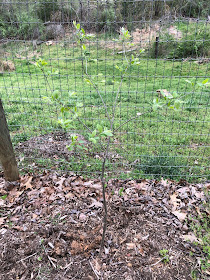I’ve never gathered any of the persimmons myself, but think of doing it each autumn that comes.
When Duke Energy took down some of our tulip poplars in Poplar Folly two years ago we began to replace those trees with other natives that don’t grow so tall, which means they won’t ever be in danger of being cut down. Persimmon was one option that is both native, wildlife-friendly, and a pollinator, so we put one in. Here it is today:
I believe it too is a slow-growing plant, but it’s more than doubled its size at planting and I love seeing its progress. Technically we need another persimmon to pollinate for fruit, so we’ll likely add a few more this fall now that we’re seeing this one thrive.
Unlike the two young redbuds we put in at the same time, the persimmon has had no problems at all. I’m not sure what happened to the redbuds - it’s possible they just didn’t get enough water the winter we planted them. Poplar Folly is too far back for hoses, so all the watering down there has to be done with a wheelbarrow and either buckets or the wheelbarrow water bladder I bought. Most things only need dedicated watering their first year, and I track the rainfall to make it easier on us and on the plantings. Some things, like the seed I just sowed, will be left to their own hardiness and the rainfall we get.
I’m happy the persimmon is doing so well.
More info:
Diospyros virginiana
Common Name(s):
- Phonetic Spelling
- dy-OS-pe-res ver-jin-ee-AY-nah
- Description
- American Persimmon is a deciduous tree in the ebony family that is native to central and eastern USA and is found in all areas of NC. It is slow-growing and thicket forming and can be a nuisance in fields. The trees are usually separate male and female and both are needed for fruiting to occur. Flowering is in spring to early summer with fruit ripening in the fall. A string of cool days is usually needed for maturation. The 1-2 inch fruits are orange and very sweet when ripe. They are a source of food for many types of birds and mammals.Moist, well-drained sandy soils provide the best conditions for growth but the tree will tolerate hot, dry, poor soils and clay, including urban conditions. It blooms and fruits best in full sun to partial shade. A deep taproot makes it difficult to transplant.Cultivars are available that may make a better tree for the home garden. However, the specimen can be grown as an ornamental and fruit tree or use in naturalized areas for wildlife.


Persimmons grow wild in the woods here on the island, along with grapes. I have harvested enough to make jelly a few years - years when the weather gods were benevolent and chose not to smite us with a hurricane. The fruit needs a frost to be edible. The color of the juice is beautiful, and the flavor - unique. Astringent, as well as tart. Improves with the addition of sugar... :D
ReplyDeleteSo cool that you made jelly! I’ve known about the first frost rule but have just never managed to get my act together to gather them after that and use them. The tree on the upper strip has been there since the people who sold this land for our neighborhood were kids, and they told me their mom used to make persimmon pie with fruit from this tree. I may try it this fall.
ReplyDeleteI’ve had persimmon jam and persimmon pudding years back. I think there must have been a lot of sugar because I don’t remember much tartness. :)))